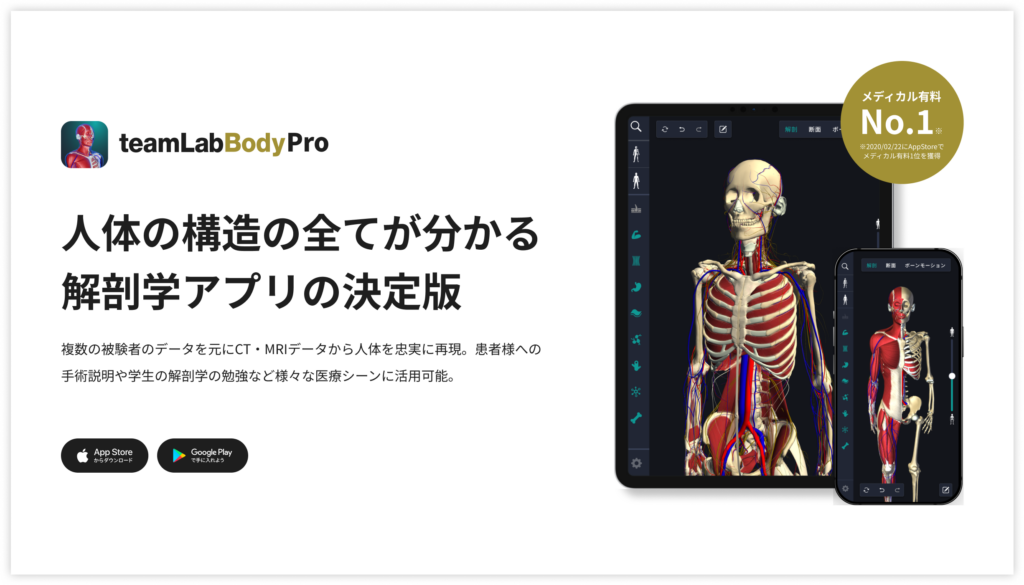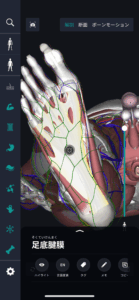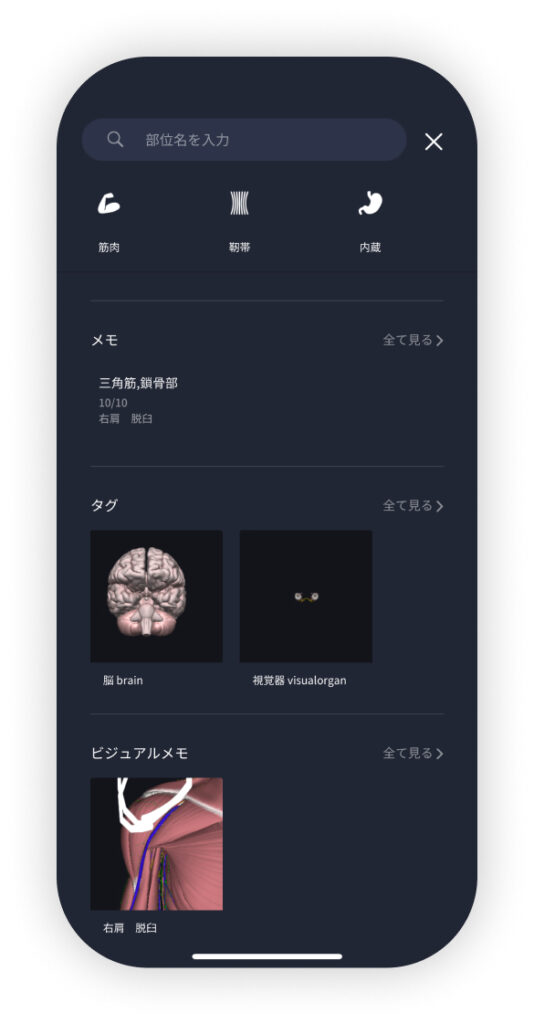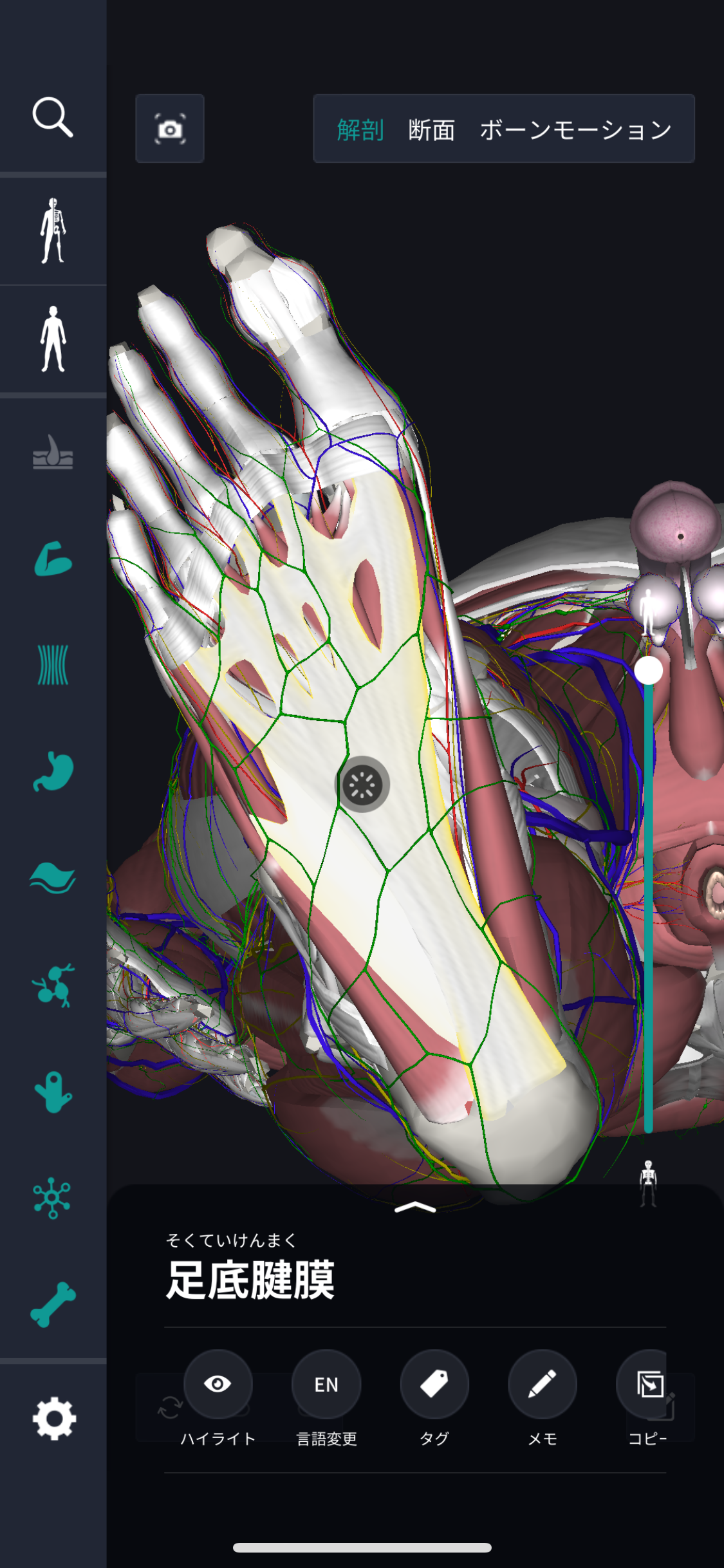beginning
In this article, I will explain effective study methods, starting with knowledge of specialized parts in human anatomy.
In human anatomy, it is necessary not only to memorize the names of various organs, muscles, and bones, but also to remember where they are located in the body. Therefore, it is necessary to learn as efficiently as possible.
I hope you can read this article and use the app to deepen your understanding even a little bit.
Now, I'll explain the details about “plantar aponeurosis” and how to study human anatomy.
teamLab Body Pro Free Download
A 3D anatomy app that shows all the structures of the human body
Download teamLab Body Pro here!

What is plantar aponeurosis?
In the anatomy application, you can view a selection of anatomy 3D models. In this model, there are various observation methods such as surfaces, cross-sections, and nervous systems. This time, I'll explain using an anatomy application.
About plantar aponeurosis

Plantar aponeurosis (plantar aponeurosis) is a thick, strong band of connective tissue located on the bottom of the foot, starting from the calcaneus (calcaneus) and spreading in a fan shape toward the base of the toes. This structure forms a vertical arch and plays a role in maintaining its stability. The plantar aponeurosis absorbs shock applied during walking or running, and enhances walking efficiency by efficiently storing and repelling energy. Structurally, it is composed of collagen fibers and combines elasticity and strength. From a medical point of view, excessive load on the plantar aponeurosis can cause inflammation and microscopic damage. This leads to the onset of plantar aponeurosis. The main symptoms of plantar aponeurosis include sharp pain in the front of the heel or plantar area, especially felt after waking up or after a long period of rest. This pain may decrease through activity during the day, but may increase again with prolonged exercise or standing.
Study points
Location and structure of plantar aponeurosis
The plantar aponeurosis (plantar aponeurosis) is a thick band of connective tissue located on the bottom of the human foot and plays an important role. This aponeurosis starts from the heel bone (heel) and extends toward the base of the toe, forming the arch shape of the foot. Structurally, it is composed of tough collagen fibers composed of multiple layers, and its main function is to support and stabilize the vertical arch of the foot. The plantar aponeurosis plays an important role when walking and standing, and maintains overall foot balance and mobility by properly distributing body weight and absorbing shock. When people walk or run, the plantar aponeurosis maintains an arcuate structure, and the arch adapts dynamically to help transport and release energy efficiently. Furthermore, this aponeurosis cooperates with the ligaments and muscles of the foot and supplements the supporting function of the foot in various daily activities. In this way, the sturdy structure and strategic positioning of the plantar aponeurosis are factors that maximize foot function. Therefore, keeping the plantar aponeurosis healthy also contributes to improving overall physical function.
The role and function of plantar aponeurosis
The plantar aponeurosis (plantar aponeurosis) plays an important role in supporting the arch of the foot and is an essential element in foot function. This allows you to maintain the arch of your foot and effectively support your body weight when standing or walking. The aponeurosis extends from the heel (heel) bone to the base of the toe, and its tension maintains the stability of the arch. When walking, the plantar aponeurosis absorbs repulsive force from the ground while properly adjusting the angle of the arch of the foot, and efficiently stores and releases energy. This effectively supplies the necessary force when walking and creates propulsion. This function is also important during high-intensity exercises such as running or jumping. In addition, the plantar aponeurosis also plays a role in shock absorption, and by mitigating impact from the ground during walking or driving, it reduces stress on the entire foot and even the upper body such as the knee and lower back. This can help reduce the risk of chronic pain and injury. Thus, the normal functioning of the plantar aponeurosis directly contributes to improved comfort and performance in everyday life and sports activities. Choosing the right footwear and stretching can help maintain aponeurosis health.
English notation for plantar aponeurosis
Plantar aponeurosis is expressed as “Plantar Fascia” in English. The term consists of two parts. First, “plantar” (planter) is derived from the Latin word “planta” and indicates “sole of the foot.” The word “plantar” is used in anatomy to indicate various structures and parts related to the plantar. For example, “plantar surface” is an expression used to indicate “the back of the foot.” On the other hand, this term is sometimes contrasted with “dorsal,” which represents “dorsal side.” Next, “fascia” (fascia) anatomically means “fascia” or “sheet of connective tissue.” “Fascia” is a dense fibrous connective tissue found in various parts of the body, and plays a role in supporting muscles and internal organs while enveloping them. In the case of plantar aponeurosis, this fascia is particularly thick and robust, and covers a large area of the entire plantar. In this way, “Plantar Fascia” is located on the bottom of the foot and indicates an important structure composed of thick connective tissue. This term is very useful in understanding how aponeurosis is located and what role it has. In particular, since plantar aponeurosis performs an important function of supporting the arch of the foot, it is often taken up in sports medicine and orthopedic fields, and inflammation of the plantar aponeurosis is known as “plantar fasciitis” (plantar aponeurosis). Thus, this English notation has brought about a universal understanding of its function and related pathologies.
How to study human anatomy
I will explain specific study methods using human anatomy applications.
Check your past learning history and practice repeatedly
Here are the steps to check your anatomy learning history and practice iteratively effectively.
1. Check your learning history in the app
Reviewing your learning history with the application is an important step in effectively advancing anatomy learning. First, launch the app and go to the learning history section from the main menu. Many anatomy apps are designed to show your progress in the form of graphs and lists, so you can visually check which parts you've learned about and how much time you've spent.
By using this data, you can understand which areas you have strengths in and where you need to spend more time and effort. We also recommend using a dedicated tag or notebook function to mark areas you are particularly weak at or where you need to relearn. Regularly checking your learning history and looking back on past learning content will lead to efficient review and deepening understanding.
2.Make a plan for iterative learning
Making an efficient repetitive learning plan based on learning history is extremely effective in promoting knowledge retention. First, identify weak points and areas where you need to relearn. Next, arrange these study items into a weekly or monthly calendar and create a specific study schedule. By proceeding in a planned manner, you can learn each part evenly and avoid packing in a large amount of information at once.
Using a task management app or digital calendar to set study reminders is effective. Also, it's important to have the flexibility to regularly review progress and revise plans as needed. By having goals and proceeding with your studies in a planned manner, you can efficiently acquire anatomical knowledge.
3.Use 3D features to learn visually
By utilizing the 3D function, learning anatomy is easier to understand visually. The 3D model shows the structure of the human body three-dimensionally, and each part can be observed in detail. This makes it possible to intuitively grasp positional relationships between deep muscles and organs that are difficult to capture in a planar view. For example, you can learn even the smallest details by rotating specific muscles and bones and zooming in and out.
Also, there are many apps that have the function of displaying cross-sectional views of each part using a 3D model, which is useful for deepening understanding of internal structures. This diversity of visual information helps with memory retention and improves immediate responsiveness in tests and practice situations. By utilizing the 3D function and learning visually, you can learn anatomy knowledge more deeply and efficiently.
Use the memo function concretely

Make notes so you don't forget the things and points you've noticed while studying. The memo function can be used for different purposes, such as inputting text, saving images, and writing memos. Tag your notes to make them easier to review later.
Test your learning regularly in the form of quizzes
Regularly testing what you've learned in a quiz format is a very effective way to anchor your anatomy knowledge. Quiz-style tests help you objectively grasp your level of understanding and areas you lack while repeating knowledge.
For example, by using a learning app to conduct quizzes every specific period, you can reconfirm what you've learned and strengthen your memory. There are a wide range of quiz formats, such as multiple choice questions, fill-in-the-blank questions, and short answer questions, and each helps understanding from a different angle and develops the ability to utilize various types of knowledge.
Get feedback
If possible, get feedback from other learners and experts. It helps you find your own gaps in understanding and areas for improvement. You can also keep yourself motivated to learn by regularly testing yourself. Feeling a sense of accomplishment and progress increases motivation for continuous learning.
summary
This time, I explained how to study “plantar aponeurosis” using an application!
Thank you for reading this far.
I would be happy if reading this article helped you learn about anatomy.
Learning is a long, never-ending journey, but I sincerely wish you all the best. Let's continue to study together and work hard for the national exam!
Please look forward to the next blog.




